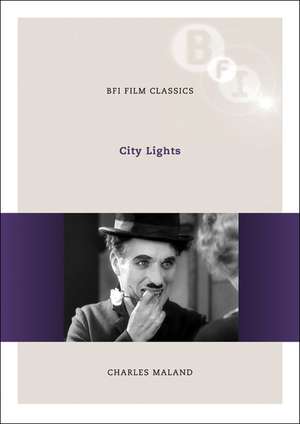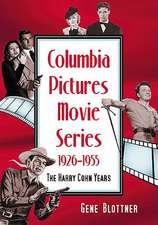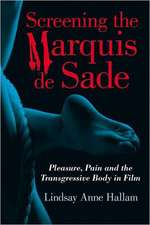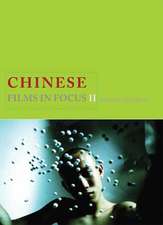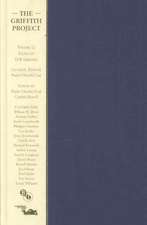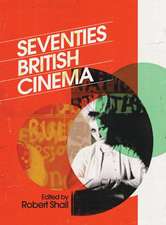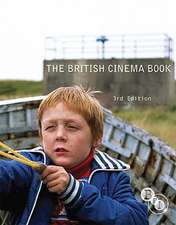City Lights: BFI Film Classics
Autor Charles J. Malanden Limba Engleză Paperback – 27 iun 2007
Din seria BFI Film Classics
-
 Preț: 81.11 lei
Preț: 81.11 lei -
 Preț: 74.79 lei
Preț: 74.79 lei - 39%
 Preț: 60.76 lei
Preț: 60.76 lei - 39%
 Preț: 60.85 lei
Preț: 60.85 lei - 39%
 Preț: 61.30 lei
Preț: 61.30 lei - 39%
 Preț: 60.85 lei
Preț: 60.85 lei - 39%
 Preț: 60.85 lei
Preț: 60.85 lei - 39%
 Preț: 61.30 lei
Preț: 61.30 lei - 40%
 Preț: 60.42 lei
Preț: 60.42 lei - 40%
 Preț: 60.42 lei
Preț: 60.42 lei - 39%
 Preț: 61.29 lei
Preț: 61.29 lei - 39%
 Preț: 60.85 lei
Preț: 60.85 lei - 39%
 Preț: 60.85 lei
Preț: 60.85 lei - 39%
 Preț: 61.30 lei
Preț: 61.30 lei - 40%
 Preț: 60.42 lei
Preț: 60.42 lei - 40%
 Preț: 59.69 lei
Preț: 59.69 lei - 37%
 Preț: 64.42 lei
Preț: 64.42 lei - 39%
 Preț: 60.85 lei
Preț: 60.85 lei - 40%
 Preț: 59.62 lei
Preț: 59.62 lei - 40%
 Preț: 60.50 lei
Preț: 60.50 lei - 39%
 Preț: 60.85 lei
Preț: 60.85 lei - 39%
 Preț: 60.85 lei
Preț: 60.85 lei - 39%
 Preț: 60.85 lei
Preț: 60.85 lei -
 Preț: 121.34 lei
Preț: 121.34 lei - 39%
 Preț: 61.76 lei
Preț: 61.76 lei - 39%
 Preț: 60.85 lei
Preț: 60.85 lei - 39%
 Preț: 60.85 lei
Preț: 60.85 lei -
 Preț: 100.10 lei
Preț: 100.10 lei - 39%
 Preț: 60.85 lei
Preț: 60.85 lei - 39%
 Preț: 61.04 lei
Preț: 61.04 lei - 39%
 Preț: 60.76 lei
Preț: 60.76 lei - 39%
 Preț: 60.85 lei
Preț: 60.85 lei - 39%
 Preț: 61.23 lei
Preț: 61.23 lei - 39%
 Preț: 61.76 lei
Preț: 61.76 lei - 40%
 Preț: 59.62 lei
Preț: 59.62 lei - 39%
 Preț: 60.85 lei
Preț: 60.85 lei - 40%
 Preț: 60.42 lei
Preț: 60.42 lei - 40%
 Preț: 60.48 lei
Preț: 60.48 lei - 37%
 Preț: 64.42 lei
Preț: 64.42 lei - 39%
 Preț: 60.85 lei
Preț: 60.85 lei - 39%
 Preț: 61.57 lei
Preț: 61.57 lei - 39%
 Preț: 61.57 lei
Preț: 61.57 lei - 40%
 Preț: 60.42 lei
Preț: 60.42 lei - 39%
 Preț: 60.85 lei
Preț: 60.85 lei - 39%
 Preț: 60.95 lei
Preț: 60.95 lei - 39%
 Preț: 61.76 lei
Preț: 61.76 lei - 39%
 Preț: 60.85 lei
Preț: 60.85 lei - 40%
 Preț: 60.60 lei
Preț: 60.60 lei - 39%
 Preț: 61.76 lei
Preț: 61.76 lei
Preț: 61.76 lei
Nou
Puncte Express: 93
Preț estimativ în valută:
11.83€ • 12.19$ • 9.91£
11.83€ • 12.19$ • 9.91£
Carte disponibilă
Livrare economică 03-17 februarie
Preluare comenzi: 021 569.72.76
Specificații
ISBN-13: 9781844571758
ISBN-10: 1844571750
Pagini: 128
Dimensiuni: 135 x 190 x 8 mm
Greutate: 0.23 kg
Ediția:2007
Editura: British Film Institute
Colecția British Film Institute
Seria BFI Film Classics
Locul publicării:London, United Kingdom
ISBN-10: 1844571750
Pagini: 128
Dimensiuni: 135 x 190 x 8 mm
Greutate: 0.23 kg
Ediția:2007
Editura: British Film Institute
Colecția British Film Institute
Seria BFI Film Classics
Locul publicării:London, United Kingdom
Notă biografică
CHARLES
MALAND
is
a
Professor
of
Cinema
Studies,
American
Studies
and
English
at
the
University
of
Tennessee
Textul de pe ultima copertă
In 1967 Charlie Chaplin told an interviewer, 'I think I likeCity Lightsthe best of
all my films'. Speaking of the film's famous ending, James Agee wrote that 'it
is enough to shrivel the heart to see'. AlthoughCity Lightshad a long and
extremely difficult production history, the final film, in Alistair Cooke's apt
words, flows 'like water over pebbles, smooth and simple for all to see with no
hint of the groaning pressure that had gone into it'.
It could easily have been otherwise. Chaplin began the film in 1927, even before
the release ofThe Circus, just months after a highly publicized divorce from his
second wife and in the midst of a tax dispute with the US government, both of
which cost him dearly. In addition, Chaplin's mother, with whom he had a
close and complex relationship, died in August 1928. Besides the burden of
these financial and emotional strains, Chaplin also had to contend with the
transition of the American film industry to the talkies and the downward
spiral of the depression following the Stock Market Crash in October 1929. He
chose a novice actress, Virginia Cherrill, as the female lead for the film, and
during production he fired the man originally cast as the millionaire and fired,
then re-hired, Cherrill. Yet he pressed forward, releasing the film to much
acclaim and box-office success in the first two months of 1931.
Aesthetically, technologically, and culturally,City Lightsis a key transitional
film in Chaplin's body of work, as the director/writer/actor responded for
the first time to sound films and stepped in the direction of the social
commentary that would become more overt inModern Times(1936) and
The Great Dictator(1940). Based on extensive archival research of Chaplin's
production records, Charles Maland'sCity Lightsoffers a careful history of the
film's production and reception, as well as a close examination of the film
itself, with special attention to the sources of the final scene's emotional power.
